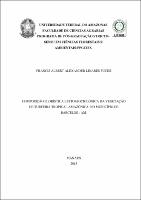| ???jsp.display-item.social.title??? |


|
Please use this identifier to cite or link to this item:
https://tede.ufam.edu.br/handle/tede/4960| ???metadata.dc.type???: | Dissertação |
| Title: | Composição florística e fitossociológica da vegetação de turfeira tropical amazônica, no município de Barcelos - AM |
| ???metadata.dc.creator???: | Fuchs, Francis Albert Alexander Linares  |
| ???metadata.dc.contributor.advisor1???: | Tello, Julio César Rodríguez |
| ???metadata.dc.description.resumo???: | Considerando que as turfeiras são um tipo de formação do solo recentemente relatadas para Amazônia Topical, atuando como grandes depósitos de carbono. O objetivo da pesquisa foi analisar a estrutura fitossociológica, composição florística e a diversidade da vegetação que ainda não foram relatadas para esse ecossistema, porém de pose das informações referentes ao solo local. A pesquisa foi conduzida a 100 km do Município de Barcelos-AM, na vegetação da turfeira, na margem direita do igarapé Palataque. A amostragem utilizada foi de parcelas múltiplas, alocadas aleatoriamente em 5 parcelas de 0,5 ha, a uma distância de 500 m cada uma, amostrando-se todos os indivíduos como D.A.P ≥ 10 cm. Encontrando-se 2004 indivíduos distribuídos em 42 espécies e 4 morfoespécies, representando 35 gêneros e 19 famílias botânicas. De acordo com o diagrama de abundância, demostrou-se que a área de estudo está em equilíbrio, atuando como potencial reservatório de carbono. A partir da análise fitossociológica ficou evidente que a espécie Calophyllum brasiliense, foi a melhor representada pelas maiores porcentagens de densidade, frequência e abundância, registrando também um maior valor de importância dentro da comunidade vegetal. O resultado do índice de Shannon permitiu concluir que a comunidade vegetal de turfeira tropical teve uma heterogeneidade relativamente elevada de espécies (2,7), pois os valores registrados em ambientes úmidos da Amazônia, encontra-se entre 2,5 e 3,0. A representatividade das espécies pelo índice de equabilidade de Pielou, foi de 0,7 acusando que o maior número de indivíduos se encontraram distribuídos em poucas espécies. Pelos resultados da curva de distribuição diamétrica o modelo matemático de melhor ajuste das variáveis foi a curva exponencial negativa, e a estrutura vertical teve uma distribuição predominante no estrato médio, a espécie Aspidosperma sandwithianum foi a única que se encontrou no estrato superior médio, representados por indivíduos com porte médio. De fato, pelas características do ecossistema a turfeira estudada, encontra-se em fase de desenvolvimento, ou seja, em processo de transformação de minerotrófica para ombrotrófica. |
| Abstract: | Whereas the bogs are plant, community recently reported for Amazon Topical, acting as major carbon sinks. The objective of the research was to analyze the vegetation structure, species composition and diversity of vegetation that have not been reported for this ecosystem, but pose the information relating to the ground of the site. The research was conducted at 100 km from the city of Barcelos-AM, in the bog vegetation on the right bank of the stream Palataque. The sample was used for multiple parcels, five randomly allocated portions of 0.5 h, at a distance of 500 m each, sampling up all individuals as D.A.D ≥ 10 cm. Finding 2004 individuals in 42 species and 4 morphospecies, representing 35 genera and 19 botanical families. According to the abundance diagram, it demonstrated that the study area is in balance, acting as a potential carbon sink. From the phytosociological analysis it became clear that the Brasiliense Calophyllum species, was the best represented by higher density percentages, frequency and abundance recorded also getting a higher value of importance within the plant community. The result of the Shannon index showed that the plant community of tropical peatland had a low diversity of species (2.7) as the amounts recorded in humid environments of the Amazon, lies between 2.5 and 3.0. The representativeness of the species evenness of Pielou index was 0.7 charging that the largest number of individuals met distributed in a few species. The results of the diameter distribution curve the mathematical model obtained was a negative exponential curve, and the vertical structure has a predominant distribution in the middle stratum, the species Aspidosperma sandwithianum was the one that found the average upper stratum, represented by individuals with size average. Indeed, the conditions that the ecosystem presents the peatland is studied in the development phase, ie minerotrófica ombrotrófica the transformation process |
| Keywords: | Composição florística Estrutura fitossociológica Turfeira tropical amazônica |
| ???metadata.dc.subject.cnpq???: | CIÊNCIAS AGRÁRIAS |
| Language: | por |
| ???metadata.dc.publisher.country???: | Brasil |
| Publisher: | UNIVERSIDADE FEDERAL DO AMAZONAS |
| ???metadata.dc.publisher.initials???: | UFAM |
| ???metadata.dc.publisher.department???: | Faculdade de Ciências Agrárias |
| ???metadata.dc.publisher.program???: | Programa de Pós-graduação em Ciências Florestais e Ambientais |
| Citation: | FUCHS, Francis Albert Alexander Linares. Composição florística e fitossociológica da vegetação de turfeira tropical amazônica, no município de Barcelos - AM. 2015. 56 f. Dissertação (Mestrado em Ciências Florestais e Ambientais) - Universidade Federal do Amazonas, Manaus, 2015. |
| ???metadata.dc.rights???: | Acesso Aberto |
| URI: | http://tede.ufam.edu.br/handle/tede/4960 |
| Issue Date: | 2-Jun-2015 |
| Appears in Collections: | Mestrado em Ciências Florestais e Ambientais |
Files in This Item:
| File | Description | Size | Format | |
|---|---|---|---|---|
| Dissertação -Francis Albert A. L. Funchs.pdf | Reprodução Total Autorizada | 1.8 MB | Adobe PDF |  Download/Open Preview |
Items in DSpace are protected by copyright, with all rights reserved, unless otherwise indicated.




